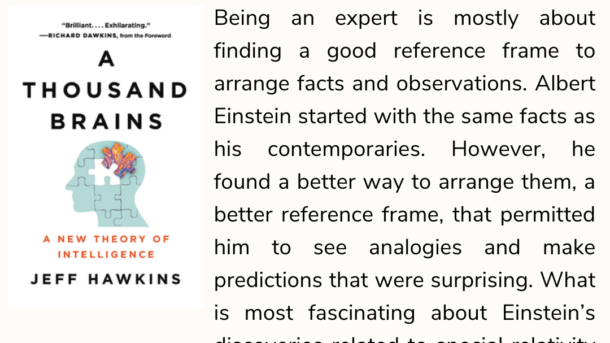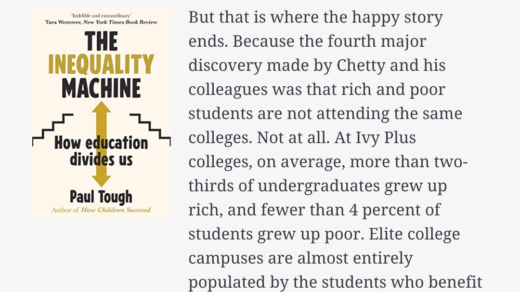To be an expert in any domain requires having a good reference frame, a good map. Two people observing the same physical object will likely end up with similar maps. For example, it is hard to imagine how the brains of two people observing the same chair would arrange its features differently. But when thinking about concepts, two people starting with the same facts might end up with different reference frames. Recall the example of a list of historical facts. One person might arrange the facts on a timeline, and another might arrange them on a map. The same facts can lead to different models and different worldviews. Being an expert is mostly about finding a good reference frame to arrange facts and observations. Albert Einstein started with the same facts as his contemporaries. However, he found a better way to arrange them, a better reference frame, that permitted him to see analogies and make predictions that were surprising. What is most fascinating about Einstein’s discoveries related to special relativity is that the reference frames he used to make them were everyday objects. He thought about trains, people, and flashlights. He started with the empirical observations of scientists, such as the absolute speed of light, and used everyday reference frames to deduce the equations of special relativity. Because of this, almost anyone can follow his logic and understand how he made his discoveries. In contrast, Einstein’s general theory of relativity required reference frames based on mathematical concepts called field equations, which are not easily related to everyday objects. Einstein found this much harder to understand, as does pretty much everyone else. In 1978, when Vernon Mountcastle proposed that there was a common algorithm underlying all perception and cognition, it was hard to imagine what algorithm could be powerful enough and general enough to fit the requirement. It was hard to imagine a single process that could explain everything we think of as intelligence, from basic sensory perception to the highest and most admired forms of intellectual ability. It is now clear to me that the common cortical algorithm is based on reference frames. Reference frames provide the substrate for learning the structure of the world, where things are, and how they move and change. Reference frames can do this not just for the physical objects that we can directly sense, but also for objects we cannot see or feel and even for concepts that have no physical form. Your brain has 150,000 cortical columns. Each column is a learning machine. Each column learns a predictive model of its inputs by observing how they change over time. Columns don’t know what they are learning; they don’t know what their models represent. The entire enterprise and the resultant models are built on reference frames. The correct reference frame to understand how the brain works is reference frames.
How can one really improve the way one thinks? From what I’ve read so far, from this book and many others, the key is to first being able to cycle through different frameworks and mental models for every situation.
One example would be like in this excerpt, to simply use different reference frames to organise events, such as viewing them on a timeline or geographically on a map. Doing each of them would yield substantially different insights and inspirations.
Have a relationship problem with your family? That’s where experience comes in. Reference many different experiences (those that you have personally experienced and or those learned from others). Reference different cultural values (Asian vs Western), to understand different ways of thinking about the same situation.
I find one becomes most rigid when one subscribes to 1 model of thinking and views all world facts through that frame. I.e Going through life thinking that capitalism is the roof of all evil. I.e Going through life think that its your sole life duty to ensure your child succeeds in a certain way. There is nothing wrong with rigidly subscribing to 1 way to reference the world, but you’ll probably end up being disappointed, let down or be that stubborn old person in that corner since there are many varied outcomes and everyone has their own way of viewing things.
Experts learn to view things and reference facts in a domain where other people can’t. It also explains why cross functional teams from different domains working together can be more creative.



